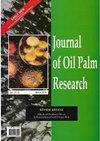棕榈油厂废水作为生物燃料和通过石油回收生产增值产品的来源:综述
IF 1.3
4区 农林科学
Q2 Agricultural and Biological Sciences
引用次数: 0
摘要
本文章由计算机程序翻译,如有差异,请以英文原文为准。
PALM OIL MILL EFFLUENT (POME) AS A SOURCE OF BIOFUELS AND VALUE-ADDED PRODUCTS VIA OIL RECOVERY: A REVIEW
Large scale palm oil production will inevitably generate a vast amount of liquid waste, particularly palm oil mill effluent (POME), that has adverse environmental impacts. While most studies concentrate on the organic removal from POME, the recovery of valuable resources from the effluent is infrequently described. The rising awareness of sustainability has motivated palm oil millers and academics to enhance waste management while also placing cognizance need for the resource’s recovery. POME possesses a substantial amount of oil and grease (O&G), which can be valorised into value-added products such as biofuels or phytonutrients via oil recovery. Recovering oil loss through POME not only prevents income loss but also improves downstream treatment effectiveness. In this article, the perspective of oil recovery from POME, focusing on technologies like physical separation, chemical extraction, and ultrasonic irradiation as a pre-treatment will be discussed, along with their effectiveness and limitations. Additionally, future opportunities as well as the economic viewpoint will be looked upon to provide a comprehensive outlook. Overall, this article will provide the readers with an understanding of the significance of recovering oil from POME and its potential as a sustainable resource, contributing to effective waste management and supporting a circular economy.
求助全文
通过发布文献求助,成功后即可免费获取论文全文。
去求助
来源期刊

Journal of Oil Palm Research
农林科学-食品科技
CiteScore
2.60
自引率
30.80%
发文量
69
审稿时长
>12 weeks
期刊介绍:
JOURNAL OF OIL PALM RESEARCH, an international refereed journal, carries full-length original research papers and scientific review papers on various aspects of oil palm and palm oil and other palms. It also publishes short communications, letters to editor and reviews of relevant books. JOURNAL OF OIL PALM RESEARCH is published four times per year, i.e. March, June, September and December.
 求助内容:
求助内容: 应助结果提醒方式:
应助结果提醒方式:


